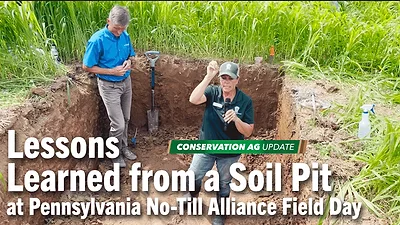Having broadcast dry fertilizer for years, Nebraska strip-tillers Ray and Kevin Kucera began to question the long-term value of the practice, especially after moving to strip-till 5 years ago.
“Placing potassium and phosphorus on top of the soil, even with strip-till, I wondered how much of those nutrients were actually being grabbed by the closing discs and kept in the berm?” says Ray, who strip-tills corn and soybeans on a 2,000-acre operation near Cedar Bluffs, Neb. “We’re 70% irrigated, but we can get some big rains and my guess is that some of those nutrients were washing down hillsides and not ending up in the root zones.”
Last year, the Kuceras moved to banded placement of dry fertilizer in the fall with a pull-behind Montag dry fertilizer delivery system on their 12-row Strip Cat knife rig, made by Twin Diamond Industries.
The targeted placement of fertility resulted in a 50% savings in application costs, says Ray, and improved strip-tilled corn and soybean stands this spring.
“Plants have been able to access those nutrients to keep them green and growing early in the season,” Ray says. “It’s a big improvement over what we saw in the past because there’s less risk of losing that fertilizer. And environmentally, it looks much smarter.”
Stacking Fertility
The Kuceras say moving away from conventional tillage to strip-till for corn improved fall nitrogen placement. They use a 1¾-inch mole knife to apply about 180 pounds of nitrogen as anhydrous ammonia in fall-built strips, 10 inches below the soil surface, using Raven flow valves to vary the rate.
|
|
The deep placement allows the corn plants to access nutrients when needed in spring, but also allows for layered application of phosphorus and potassium in the strip.
“We’ve been working with the University of Nebraska to study the effects of placing the next year’s fertilizer in a band in the root zone with the fall strip-till pass,” Ray says. “Past experience showed that going 4 to 6 inches deep with our dry fertilizer above the anhydrous will avoid root burn because the anhydrous will be diluted enough by the time to roots get there.”
Using RTK through John Deere’s 2630 display and StarFire 3000 receiver on their Deere tractor, the Kuceras band about 80 pounds per acre of monoammonium phosphate (MAP), 20 pounds per acre of potassium and 5 pounds an acre of sulfur in the strip for both corn and strip-tilled soybeans.
In spring, they apply about 5½ gallons per acre of liquid ammonium phosphate (10-34-0) in-furrow with their 18-row John Deere corn planter.
“We sidedress with irrigation because we’ve found that the starter package with the planter gives the corn plant a good jumpstart in spring,” Kevin says. “And that’s one of the reasons we wanted to be more efficient with our fertilizer application.”
Saving Topsoil
Improving water infiltration was a primary objective in moving away from conventional tillage, Kevin says, because they would often have to replant corn after heavy rains washed out cornfields.
|
|
“We’d either have to plant around those areas or we weren’t getting seeds in the ground because they’d just lay in the trench and then wash down a hill if we got a good rain,” Kevin says. “Now, we’re seeing a lot less ponding and a lot less in-season field maintenance.”
Keeping more residue on the soil surface is helping to retain moisture and improve soil structure, which in turn is leading to more consistent corn yields, Ray notes. Although he says it’s hard to put a number to the yield increase they’ve seen with strip-till over conventional tillage, having more “farmable” acres is providing more yield stability.
“With strip-till, we’ve been able to increase our farmable acres by about 5% because of improved water infiltration, and that’s certainly contributing to more consistent yields,” Ray says.
The Kuceras average more than 200 bushels per acre on their irrigated strip-tilled corn, and about 150 bushels per acre on their dryland strip-tilled corn.
Soybean Success
The desire for more consistent yields drove the Kuceras to try strip-tilling about 700 acres of soybeans last fall after many years of no-till. One challenge they faced with no-till was getting good seed-to-soil contact through corn residue.
|
|
“Sometimes we’d end up with soybeans on top of the ground or under a mound of residue and they wouldn’t get much sunlight,” Kevin says. “Neighboring seeds might be an inch tall, while the seeds under the residue struggled to emerge — which would lead to inconsistent stands and yields.”
Clearing the seedbed of residue with the strip-till pass and using Yetter spike wheel row cleaners and Copperhead Ag Furrow Cruiser closing wheels on the planter, has improved seed-to-soil contact and allowed the Kuceras to plant soybeans slightly deeper than in the past.
“We’re going about 1½ inch deep, compared to about a 1-2 inches before with no-till,” Ray says. “We’re hoping that the consistent depth placement is going to give us the most consistency with yields because there won’t be that layer of residue to break through, but still enough moisture in that strip.”
This past spring, early emergence of strip-tilled soybeans was exceptional, Ray says.
“Planting was a lot easier this year and we’re seeing good early growth,” he says. “Lots of green, compared to the green and yellow we’d typically see with no-till soybeans at this stage.”









